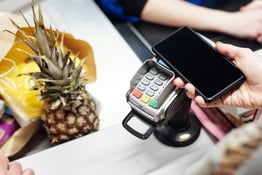Are you using your restaurant management system to the fullest of its capabilities? Most restaurants use some type of POS system to process orders and store sales data. But POS features for restaurants go well beyond these basic functionalities. Newer platforms are rich with features designed to improve your restaurant’s efficiency, productivity, and profitability.
It’s up to you, however, to take full advantage of these features.
To learn more, we spoke with a number of leading POS vendors who offered up their insights on the most valuable and underused POS features for restaurants. Based on their advice, we've identified 7 powerful POS features that every restaurant operator should know about.
1. Inventory Management
Most POS systems include tools for monitoring stock levels. But are you using your inventory management tools to view downloadable reports, monitor inventory levels in real time, or automate recording for key ingredients?
"If we aren’t managing our inventory with the aid of technology and on a regular cadence, we are doing ourselves a disservice," said Ben Simmons, co-founder of online ordering and payment platform Table Needs. "Your POS may not be able to tell you what your targets should be, but it can assist in consistent tracking to waste less and keep fresher ingredients.”
Make sure you are leveraging your POS system’s inventory management features to their fullest capabilities, and that you are using these capabilities to streamline ordering, storage, and waste reduction.
2. Product Mixes (PMIX)
Similar to inventory management, a PMIX can help you plan ahead and prevent waste. The item-by-item menu sales report lists the quantity of each menu item you’ve sold in a given day, along with sales revenue.
“Many legacy POS systems would track PMIX, but very often that data lived in a downloadable spreadsheet that rarely got utilized," said Bryan Solar, Square’s head of restaurants. "Modern POS’s make PMIX instantly available and easily digestible.”
The PMIX feature gives you a clearer sense of which dishes are customer favorites and which dishes are underperforming. Use these insights to optimize your menu and eliminate waste.
3. Staff Scheduling and Labor
POS features for restaurants typically include advanced staff management tools that you can use to optimize scheduling and control your labor costs.
“Having a good balance to your food and labor costs can mean the difference to growing a single location into a franchise or bankruptcy," noted Omer Choudhary, owner of restaurant software solutions company Truffle. "Utilizing your POS reporting system to get an overview of these costs is a simple, effective way to discover where you can ‘trim some fat’ on your staff during down time.”
Your restaurant management system may even include tools for monitoring employee performance metrics. For instance, Lightspeed general manager of hospitality Peter Dougherty encourages Lightspeed users to take advantage of the fact that their “POS provides a ‘server scorecard’, identifying how your guest-facing staff performs in terms of overall sales and tips, so you can make sure you’re optimizing every shift.”
If you aren’t sure which of these staffing features are included with your POS, reach out to your vendor for support. Using these features the right way can streamline your distribution of labor and lower operational costs.
4. Kitchen Display Systems
If your current POS system includes a Kitchen Display System (KDS), you are likely already using it. But if yours is one of the many restaurants still running your kitchen on the “paper ticket” method, it might be time to upgrade.
A KDS is a digital order viewer that replaces your kitchen printers, and allows you to view, track, and fulfill orders using a digital ticket system. This feature provides a critical line of communication between the front of house and back and house, allowing for seamless coordination between ordering, prep, and payment processing.
“If you think of the kitchen as the heart of a restaurant's engine, a KDS is how restaurants can supercharge that engine by creating instant visibility to the status of the line," explained Solar. "This means no more customers who accidentally were waiting far too long for an order, and no more guesswork at the end of a shift about how the night went based on order flow.”
If your POS system doesn’t include a KDS, you may want to discuss upgrading with your vendor. If your POS system does include a KDS, make sure you are tapping into all of its capabilities.
5. Marketing
POS features for restaurants typically also include advanced digital marketing capabilities. An increasing number of providers now offer targeted email and text marketing campaign services. These digital outreach strategies can improve customer loyalty and drive repeat business.
“If you have the ability to blast out a text, email, or social media message to your customers about your specials or promotions, or just to remind them that they can order their lunch or dinner online and schedule it ahead of time, do it,” said Simmons. “Many owners don’t know what to market. Market your product, [or] use your online and scheduled ordering, and market that. After all, [customers] won’t use it if you don’t remind them that it exists.”
Your POS system is a rich repository of data on sales history and customer preferences. Use these features to identify distinct segments of your market, shape your messaging, and create promotions that will resonate with your customers.
6. Integration Tools
POS features for restaurants may include a wide range of integrations including customer loyalty programs, reservation booking software, and delivery tracking. Integrating your POS with other third-party platforms allows for seamless data sharing, improved efficiency, and centralized control over numerous aspects of your business.
Online ordering integration is a particularly important feature today.
“We’ve found that the average ticket size increases when orders are placed online,” said Samir Zabaneh, chairman and CEO of restaurant management system provider TouchBistro.
If you’re not sure what integrations are included with your restaurant management system, reach out to your vendor for support.
7. POS Staff Training
Your restaurant management system should include training features and materials to ensure that your staff and leadership can adopt and use their new platform with minimal disruption. Simmons notes that embedded videos and training programs are usually a sign of a strong POS system.
“You should look into whether or not your provider has put the time and resources into creating this. If they have not, consider a new provider,” Simmons advised.
Of course, upgrading to a new POS system or considering a new provider is a heavy lift for operators, as missteps can cause business disruptions that impact profits. If you'd like to discuss your options before taking action, schedule a free discovery call with one of our experts to talk through all of your options.
Additional reporting by Grace Dickinson





